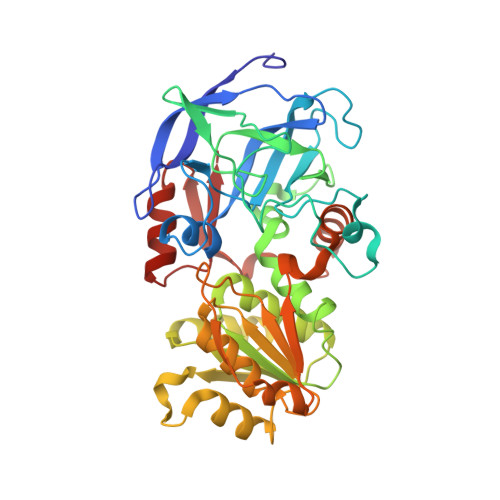Horse Liver Alcohol Dehydrogenase: Zinc Coordination and Catalysis.
Plapp, B.V., Savarimuthu, B.R., Ferraro, D.J., Rubach, J.K., Brown, E.N., Ramaswamy, S.(2017) Biochemistry 56: 3632-3646
- PubMed: 28640600
- DOI: https://doi.org/10.1021/acs.biochem.7b00446
- Primary Citation of Related Structures:
5VJ5, 5VJG, 5VKR, 5VL0, 5VN1 - PubMed Abstract:
During catalysis by liver alcohol dehydrogenase (ADH), a water bound to the catalytic zinc is replaced by the oxygen of the substrates. The mechanism might involve a pentacoordinated zinc or a double-displacement reaction with participation by a nearby glutamate residue, as suggested by studies of human ADH3, yeast ADH1, and some other tetrameric ADHs. Zinc coordination and participation of water in the enzyme mechanism were investigated by X-ray crystallography. The apoenzyme and its complex with adenosine 5'-diphosphoribose have an open protein conformation with the catalytic zinc in one position, tetracoordinated by Cys-46, His-67, Cys-174, and a water molecule. The bidentate chelators 2,2'-bipyridine and 1,10-phenanthroline displace the water and form a pentacoordinated zinc. The enzyme-NADH complex has a closed conformation similar to that of ternary complexes with coenzyme and substrate analogues; the coordination of the catalytic zinc is similar to that found in the apoenzyme, except that a minor, alternative position for the catalytic zinc is ¡«1.3 ? from the major position and closer to Glu-68, which could form the alternative coordination to the catalytic zinc. Complexes with NADH and N-1-methylhexylformamide or N-benzylformamide (or with NAD + and fluoro alcohols) have the classical tetracoordinated zinc, and no water is bound to the zinc or the nicotinamide rings. The major forms of the enzyme in the mechanism have a tetracoordinated zinc, where the carboxylate group of Glu-68 could participate in the exchange of water and substrates on the zinc. Hydride transfer in the Michaelis complexes does not involve a nearby water.
Organizational Affiliation:
Department of Biochemistry, The University of Iowa , Iowa City, Iowa 52242, United States.


















